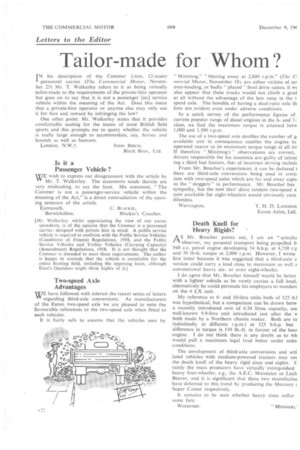Tailor-made for Whom?
Page 58

If you've noticed an error in this article please click here to report it so we can fix it.
IN his description of the Commer i-ton, 12-seater I personnel carrier (The Comtnercial Motor, November 25) Mr. T. Walkerley refers to it as being virtually tailor-made to the requirements of the private-hire operator but goes on to say that it is not a passenger [sic] service vehicle within the meaning of the Act. Does this mean that a private-hire operator or anyone else may only use it for hire and reward by infringing the law?
One other point: Mr. Walkerley states that it provides comfortable seating for the teams of most British field sports and this prompts me to query whether the vehicle is really large enough to accommodate, say, horses and hounds as well as humans.
London, N.W.5. JOHN BIRCH, Birch Bros., Ltd.
Is it a Passenger Vehicle ?
wE wish to express our disagreement with the article by " Mr. T. Walkerley. The statements made therein are very misleading, to say the least, His comment, "The Commer is not a passenger-service vehicle within the meaning of the Act," is a direct contradiction of the opening sentence of the article.
Eyemouth, C. BLACKIE, Berwickshire. Blackie's Coaches.
[Mr. Walkerley, whilst appreciating the view of our correspondents, is of the opinion that the Commer is a 'personnel carrier, designed with private hire in mind. A public service vehicle is required to conform with the Public Service Vehicles (Conditions of Fitness) Regulations, 1958, and the Public Service Vehicles and Trolley Vehicles (Carrying Capacity) (Amendment) Regulations, 1958. It is not thought that the Commer is intended to meet these requirements. The author is happy to concede that the vehicle is unsuitable for the entire hunting field, including the opposing team, although Eton's Oppidans might think highly of it.)
Two-speed Axle Advantages
wE have followed with interest the recent series of letters VY regarding third-axle conversions. As manufacturers of the Eaton two-speed axle we are pleased to note the favourable references to the two-speed axle when fitted to such vehicles.
It is fairly safe to assume that the vehicles seen by
" M inimog," " blasting away at 2,600 r.p.m." (The C mercial Mvtor, November 18), are either victims of so over-loading, or badly "placed final drive ratios; it wc also appear that these trucks would not climb a grad at all without the advantage of the low ratio in the t speed axle. The benefits of having a dual-ratio axle th fore are evident even under adverse conditions.
In a quick survey of the performance figures of current popular range of diesel engines in the 6and 7class, we find the maximum torque is attained betw 1,000 and 1,500 r.p.m.
The use of a two-speed axle doubles the number of gi available and in consequence enables the engine to operated nearer to its maximum torque range at all tin If therefore " Minimog's " observations are correct, drivers responsible for his insomnia are guilty of intro() ing a third bad feature, that of incorrect driving technic From Mr. Boucher's experiences, it can be deduced t there are third-axle conversions being used in conjt tion with two-speed axles which are far and away supei to the " sloggers " in performance. Mr. Boucher has sympathy, but the new thro' drive tandem two-speed a: now available for eight-wheelers would obviously cure dilemma.
Warrington. T. H. D. LANGEIAN Eaton Axles, Ltd.
Death Knell for Heavy Rigids?
As Mr. Boucher points out, I am an " armcha observer, my personal transport being propelled b 948 c.c. petrol engine developing 34 b.h.p. at 4,750 r.p and 50 lb-ft. torque at 2,000 r.p.m. However, I wrote first letter because it was suggested that a third-axle c version could carry a load close to maximum as well a conventional heavy sixor even eight-wheeler.
do agree that Mr. Boucher himself would be better with a lighter vehicle as he rarely carries a full load, alternatively he could persuade his employers to standarc on the 6 LX unit.
My reference to 6and 10-litre units both of 125 b.1 was hypothetical, but a comparison can be drawn betw a recently introduced unit of 6.54 litres capacity, an well-known 9.8-litre unit introduced just after the both made by a Northern chassis maker. Both are ra (admittedly at different r.p.m.) at 125 b.h.p. but difference in torque is 110 lb.-ft. in favour of the heal engine. I do not think there is any doubt as to wh would pull a maximum legal load better under ardui conditions.
The development of third-axle conversions and arti lated vehicles with medium-powered tractors may sot the death knell of the heavy rigid sixes and eights. C tainly the mass producers have virtually extinguished heavy four-wheeler, e.g., the A.E.C. Mandator or Leyle Beaver, and it is significant that these two manufactur have deferred to this trend by producing the Mercury E Super Comet respectively.
It remains to be seen whether heavy sixes suffer same fate.
Worcester. " MINtmoo.'
























































































































